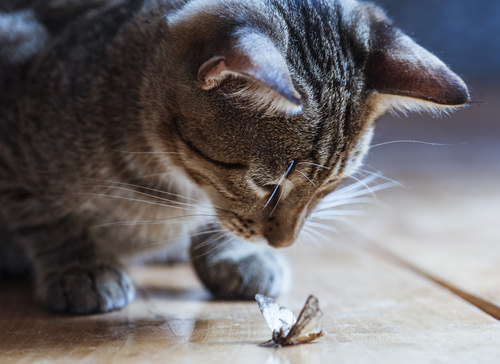
Cats get a bad reputation as wildlife killers and they certainly see some headlines about their impact on native wildlife. Part of the killer reputation comes from the presence of uneaten prey and part comes from the cat’s tendency to toy with prey items, alive and dead. Human beings see this behavior as poor sportsmanship and wasteful, even cruel.
But cats aren’t human and they are closely connected to their ancestors when it comes to hunting and prey. In a laboratory setting, well-fed cats shown a prey animal, like a rodent, would stop eating and dispatch the prey, sometimes dragging the corpse back toward the dish with the food in it. While a hungry cat is more likely to spend extra time hunting and feeding, even a well-fed cat is so enticed by the presence of a prey item that she will stop eating to approach it. 1

The mere presence of prey, with the associated scents and movements, seem to trigger a reaction in the cat that is separate from his actual hunger. Some people think it is because cats instinctively try to vary their diet to meet very specific nutritional needs associated with being a “hyper carnivore”.
Well-fed cats will almost reflexively hunt, kill and toy with prey. Some believe that they are more apt to toy with the prey because their lack of hunger causes them to be conflicted about the goal of the hunt. It seems that only when the prey item is particularly palatable will a well fed cat be likely to eat it.
This separation of appetite and hunting drive may seem odd to humans, but it is precisely this tendency that made early cats such valuable pest control to farmers and homesteaders. In the immortal words of the urban dictionary, “Don’t hate, appreciate” your cat for being who she is and how her instincts have perfectly adapted her to be where she is today.
Want to know more about cats? You can see the fur fly on Facebook!
- Adamec, R.E. (1976) The Interaction of Hunger and Preying in the Domestic Cat (Felis Catus): An Adaptive Hierarchy? Behavioral Biology, 263-272
- Bradshaw, J., Casey, R.A. and Brown, Sarah (2012) The Behaviour of the Domestic Cat: 2nd edition. 132-33.

